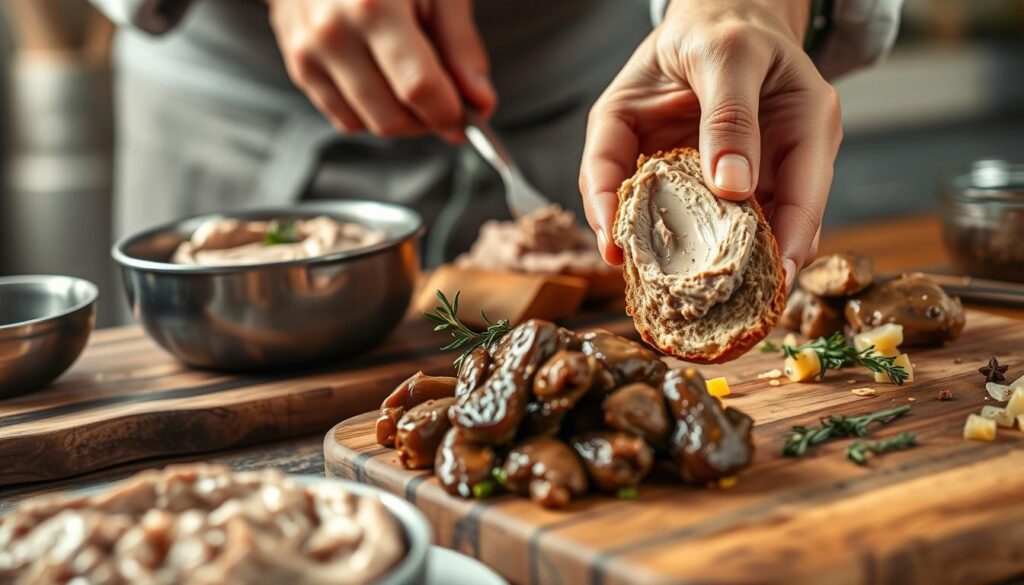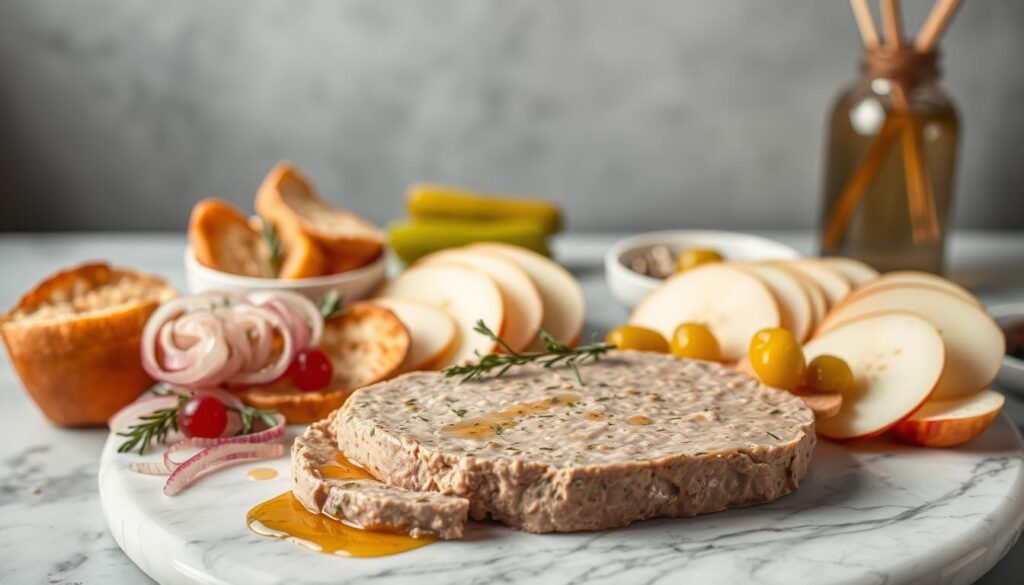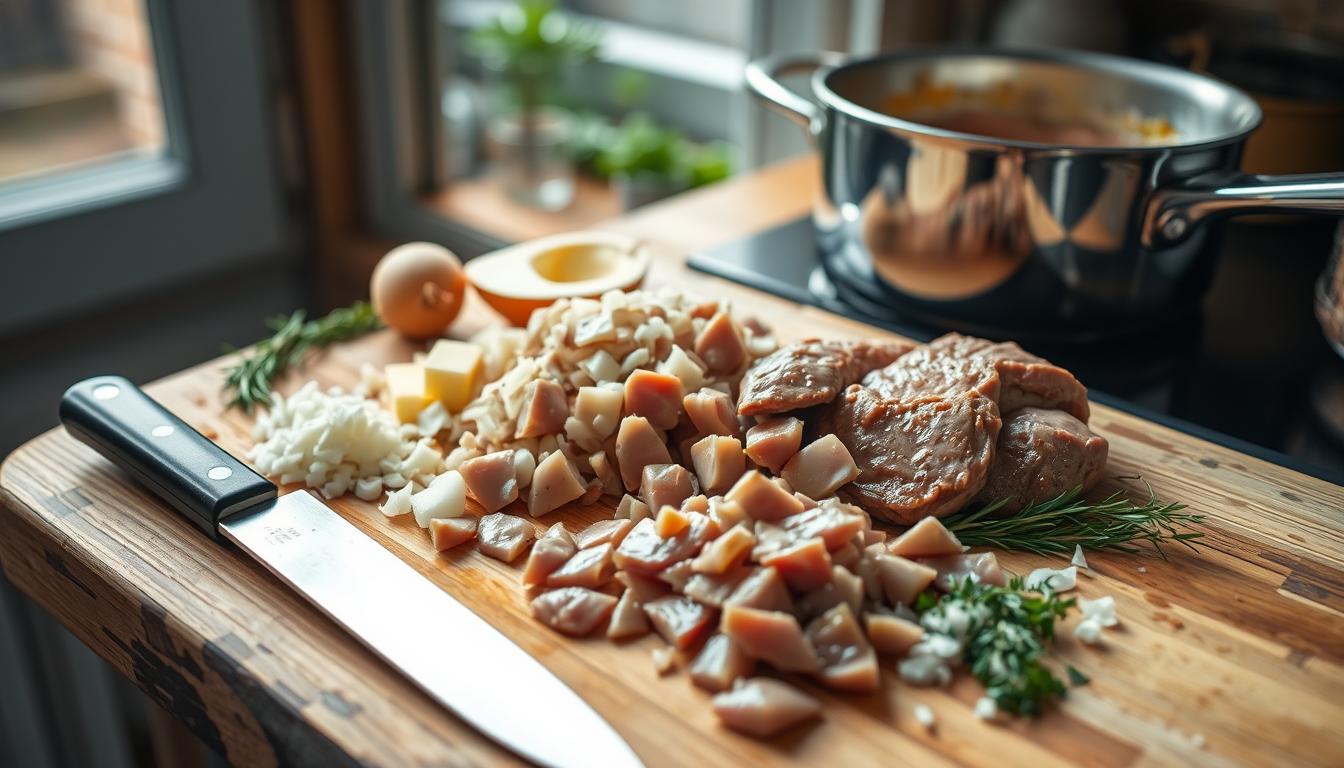Learn to make a luxurious chicken liver pate that turns simple ingredients into a gourmet treat. This homemade pate brings French elegance to your kitchen. It offers a rich, creamy spread that will wow even the pickiest eaters.
Chicken liver pate is more than a recipe; it’s a culinary journey. It turns simple ingredients into an extraordinary dish. Perfect for elegant dinner parties or sophisticated appetizers, this pate promises complex flavors and a smooth texture that will excite your taste buds.
Table of Contents
Introduction to Classic French-Inspired Pate
French pate is a culinary treasure that turns simple ingredients into a fancy delicacy. It comes from France’s rich food traditions. This traditional pate has won the hearts of food lovers for many years.
While classic pates use duck or goose liver, chicken liver pate is more affordable and easy to make at home.
The magic of French pate is its flexibility. You can serve it as a fancy appetizer, spread it on bread, or add it to dishes. What makes traditional pate unique is how it makes simple meals taste rich and complex.
- Rooted in French culinary heritage
- Adaptable to different dietary preferences
- Simple to prepare at home
- Packed with nutrients and flavor
Chicken liver pate makes gourmet food accessible to everyone. It turns simple chicken livers into a smooth, creamy spread that’s as good as the expensive kinds.
“Pate is not just a dish, it’s a celebration of culinary craftsmanship.” – French Culinary Tradition
Whether you’re an experienced cook or just starting, exploring traditional pate opens up new flavors and cooking techniques. This dish connects simple home cooking with the elegance of French cuisine.
Essential Ingredients for Perfect Liver Pate
Making a tasty chicken liver pate needs the right ingredients. These ingredients should blend well to make a smooth, rich spread. Knowing the key ingredients is key to making a pate that will wow your guests.
Selecting Quality Chicken Livers
The best pate starts with fresh, top-quality chicken livers. Choose livers that are deep red-brown and have no bad smell. Organic or free-range livers taste better and are healthier.
Butter and Cream Components
Butter and cream are vital for a smooth pate texture. Use unsalted butter for better flavor control and heavy cream for a luxurious feel.
Aromatics and Pate Seasonings
Pate seasonings make a big difference. The right mix of aromatics can turn your pate into something special.
- Garlic: Provides deep, robust flavor
- Shallots: Adds subtle sweetness
- Fresh thyme: Introduces earthy undertones
- Salt and pepper: Essential for balanced seasoning
Adding cognac or sherry can add a sophisticated touch. It makes the pate’s flavor more complex.
| Ingredient Category | Recommended Options | Purpose |
|---|---|---|
| Protein Base | Fresh chicken livers | Primary protein source |
| Fat | Unsalted butter, heavy cream | Creates smooth texture |
| Aromatics | Garlic, shallots, thyme | Enhances flavor complexity |
| Liquids | Cognac, sherry (optional) | Adds depth and richness |
Kitchen Equipment You’ll Need
Making a tasty chicken liver pate needs the right tools and equipment. These will help you get professional results. Start by picking the best kitchen gear to turn simple ingredients into a smooth spread.
- Food Processor or Blender: The most critical tool for creating a silky-smooth texture
- Heavy-bottomed Skillet: Ensures even cooking of chicken livers and aromatics
- Fine-mesh Strainer: Helps remove any unwanted bits for a refined consistency
- Ramekins or Serving Dishes: Perfect for chilling and presenting your pate
- Sharp Chef’s Knife: Necessary for precise liver trimming
You don’t need every tool to make great pate. Many home cooks make delicious pates with basic equipment. The important thing is knowing how to use what you have.
Think about getting a top-notch food processor if you make pate often. It makes the pate creamy and smooth. A good skillet is also key for cooking the chicken livers right.
Preparing and Cleaning Chicken Livers
Preparing chicken livers for pate needs precision and care. The quality of your preparation greatly affects the taste and texture of the final dish. Professional chefs agree that this is crucial.
Start by looking at the raw meat closely. You should remove any imperfections to keep your pate smooth.
Trimming Techniques
Cleaning liver for pate involves several important steps:
- Remove all visible white connective tissue
- Cut away any greenish or discolored sections
- Slice livers into uniform 4-5 cm pieces
- Rinse under cold water to eliminate any residual blood
Cleaning Process
Preparing liver for pate requires careful attention. Use a sharp knife to trim away tough membranes. Make sure each piece is clean and uniform. Gentle handling prevents damaging the delicate liver tissue.
“Perfect pate begins with impeccable ingredient preparation” – Classic French Culinary Wisdom
Rinse your chicken livers well under cold running water. Then, pat them dry with paper towels to remove excess moisture. This helps with texture and prevents splattering during cooking.
By following these detailed cleaning and preparing chicken livers techniques, you’ll make a pate that will impress everyone.
Chicken Liver Pate Recipe
Making the perfect chicken liver pate is all about precision and care. This dish turns simple ingredients into a luxurious spread that will wow your guests. It’s easier than you think to learn how to make pate.
To begin your chicken liver pate recipe, gather these ingredients:
- 1 pound fresh chicken livers
- 1/2 cup unsalted butter
- 1 medium onion, finely chopped
- 2 garlic cloves, minced
- 1/4 cup heavy cream
- Salt and pepper to taste
- 2 tablespoons brandy (optional)
Follow these steps carefully to prepare your pate:
- Clean and trim chicken livers, removing any visible membranes
- Melt butter in a large skillet over medium heat
- Sauté onions and garlic until soft and translucent
- Add chicken livers and cook until just pink in the center
- Remove from heat and let cool slightly
- Transfer mixture to a food processor
- Add cream, brandy, salt, and pepper
- Blend until smooth and creamy
- Pass through a fine-mesh strainer for extra smoothness
- Transfer to serving dish and chill for at least 2 hours
The secret to a great chicken liver pate is its silky smooth texture. Don’t overcook the livers, as this can make them grainy and tough.
“A perfect pate should be rich, smooth, and melt in your mouth” – Classic French Culinary Tradition
| Ingredient | Quantity | Purpose |
|---|---|---|
| Chicken Livers | 1 pound | Primary protein base |
| Butter | 1/2 cup | Adds richness and smoothness |
| Cream | 1/4 cup | Enhances texture |
| Brandy | 2 tablespoons | Provides depth of flavor |
Pro tip: Always serve your pate chilled and use within 3-4 days for the best flavor and texture.
Cooking Techniques and Tips
Mastering pate cooking techniques needs precision and care. The art of making a smooth pate texture is about finding the right balance. This balance comes from cooking and blending chicken livers carefully. Your success depends on controlling the temperature and using the right skills.

Professional chefs know that making the perfect pate involves several key steps:
- Maintain low to medium heat during cooking
- Watch for precise color changes in the liver
- Use gentle blending methods
- Control ingredient temperature
Temperature Control Mastery
When making your pate, temperature is key. Cook the chicken livers until they’re light brown on the outside and barely pink inside. This method ensures the best flavor without overcooking the meat.
Creating a Silky Smooth Texture
The secret to a smooth pate texture is blending slowly. Start by adding small amounts of cream and butter while blending. This helps break down the liver’s fibers, making the pate luxurious and velvety.
“Patience transforms good pate into extraordinary pate” – Classic French Culinary Wisdom
Doneness Testing Techniques
To check if your pate is ready, look for these signs:
- Uniform light brown color throughout
- Soft, spreadable consistency
- No visible pink areas in the liver
- Smooth, even texture when blended
Pro tip: Always use a reliable meat thermometer to ensure safe internal temperatures while maintaining optimal flavor and texture.
Storage and Preservation Methods
Keeping liver pate fresh is all about the details. The right storage methods can keep its taste and texture perfect for weeks. Your homemade chicken liver pate should be treated with the best care to enjoy it fully.
For liver pate, the fridge is your best friend. Here’s how to store it right:
- Refrigerate pate in an airtight container
- Cover the surface directly with plastic wrap to prevent oxidation
- Store in the coldest part of your refrigerator
Storing pate correctly can make it last longer. In the fridge, your pate stays fresh for 3-4 days. Freezing is a great choice for longer storage.
Here’s how to freeze liver pate:
- Portion pate into smaller containers
- Wrap tightly with plastic wrap
- Use freezer-safe containers
- Freeze for up to 3 months
To thaw your pate, do it slowly in the fridge. Pro tip: Never refreeze thawed pate. Enjoy it within 24 hours after thawing for the best taste and safety.
The key to perfect pate preservation is minimizing air exposure and maintaining consistent cold temperatures.
Serving Suggestions and Pairings
Make your chicken liver pate stand out with creative serving ideas. These ideas can turn a simple spread into a feast for the senses. Whether it’s a small gathering or a fancy appetizer, the right sides can make it unforgettable.

- Crisp toasted baguette slices
- Artisan crackers
- Fresh herb-garnished crostini
- Rustic sourdough bread
Traditional French Accompaniments
Classic French pairings bring out the best in liver pate:
- Cornichons (tiny pickled gherkins)
- Tangy onion jam
- Whole grain mustard
- Pickled shallots
Modern Serving Inspirations
Try new ways to present your pate, like on elegant charcuterie boards. Pair it with crisp white wines like Sauvignon Blanc or Pinot Grigio. This will balance the pate’s rich taste.
Pro tip: Serve pate chilled and let it sit at room temperature for 15 minutes before serving. This will bring out its flavors.
Try adding garnishes like fresh thyme, black pepper, or olive oil. These can make your liver pate look and taste even better.
Troubleshooting Common Issues
Making the perfect chicken liver pate can be tough. Troubleshooting pate involves fixing common texture and flavor problems. Knowing how to solve these issues can turn a kitchen failure into a success.
Fixing the pate’s texture is key. Several issues can happen during cooking that affect the pate’s quality:
- Grainy texture
- Bitter flavor profile
- Fat separation
- Uneven consistency
Now, let’s look at the most common problems and how to fix them:
| Issue | Potential Cause | Solution |
|---|---|---|
| Grainy Texture | Overcooked livers | Blend thoroughly, strain through fine mesh sieve |
| Bitter Taste | Improper liver cleaning | Remove all connective tissues, soak in milk |
| Fat Separation | Incorrect temperature | Blend at room temperature, use emulsification techniques |
When fixing pate texture, remember patience and technique are crucial. Smooth, creamy pate requires careful preparation and attention to detail.
“Perfection in pate is about understanding your ingredients and mastering your technique.” – Professional Chef
Pate troubleshooting isn’t scary. With practice and these solutions, you’ll make top-notch chicken liver pate every time.
Health Benefits and Nutritional Information
Chicken liver pate is surprisingly rich in nutrients. It can be a great addition to your diet if eaten in small amounts. The liver pate nutrition supports your overall health and wellness.
Exploring the health benefits of pate reveals its impressive nutrient profile. Chicken livers are full of vitamins and minerals. They offer a concentrated dose of essential nutrients.
Nutrient Breakdown
- Iron: Exceptionally high in bioavailable iron, supporting blood health and preventing anemia
- Vitamin A: Critical for vision, immune function, and skin health
- Protein: Provides complete protein with all essential amino acids
- Vitamin B12: Supports nervous system and red blood cell formation
Dietary Considerations
Chicken liver pate has many nutritional benefits. However, it’s high in calories and fat due to butter and cream. It’s important to control your portion size.
People with dietary restrictions should be careful. Those watching their cholesterol or following specific diets might want to eat it less often. Talking to a nutritionist can help you safely add liver pate to your diet.
Moderation is key when enjoying this nutrient-dense delicacy.
Conclusion
Making homemade chicken liver pate is more than a recipe. It’s a journey into classic French cooking. You’ve learned to turn simple ingredients into a fancy dish that will wow your guests.
Your pate is a mix of skill, taste, and tradition. It’s great as an appetizer or on bread. It shows off your cooking talent and love for fine food. Every batch you make will make you better at it.
Feel free to try new herbs, spices, or alcohol in your pate. It’s all about practice and patience to get it just right. Share your pate with others and see their amazement at your cooking skills.
Cooking is like art, and your pate is your masterpiece. Keep trying new things, tasting, and enjoying the world of gourmet cooking.


3 thoughts on “Chicken Liver Pate Recipe: Step-by-Step Guide”